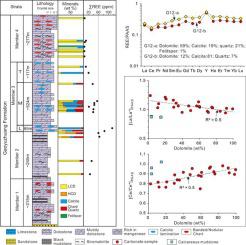当前位置:
X-MOL 学术
›
J. Asian Earth Sci.
›
论文详情
Our official English website, www.x-mol.net, welcomes your
feedback! (Note: you will need to create a separate account there.)
Rare earth elements in dolostones and limestones from the Mesoproterozoic Gaoyuzhuang Formation, North China: Implications for penecontemporaneous dolomitization
Journal of Asian Earth Sciences ( IF 2.7 ) Pub Date : 2020-07-01 , DOI: 10.1016/j.jseaes.2020.104374 Ting Liang , Zhidong Bao , Xiaoer Zhu , Yuxin Guo , Jiayu Li , Brian Jones
Journal of Asian Earth Sciences ( IF 2.7 ) Pub Date : 2020-07-01 , DOI: 10.1016/j.jseaes.2020.104374 Ting Liang , Zhidong Bao , Xiaoer Zhu , Yuxin Guo , Jiayu Li , Brian Jones

|
Abstract The Mesoproterozoic Gaoyuzhuang Formation (1.54–1.6 Ga), which is up to 1543 m thick, is a dolostone-dominated succession that originated in the Yanshan-liaoxi rift zone. In ascending order, this formation comprises Members 1 to 4. Member 1 is formed of clastic rocks and dolostones, whereas Members 2 and 4 are formed largely of dolostones. Member 3, which is divided in ascending order into three units (Members 3-L, 3-M, 3-T), is a succession of intercalated limestone and dolostone that have total rare earth elements (ΣREE) ranging from 0.5 to 116 ppm and variable Post-Archean Australian Shale (PAAS) normalized profiles. Carbonates from Member 3-M have REE profiles characterized by positive La and Y anomalies, a negative Ce anomaly, and a weak positive Eu anomaly. Relative to Member 3-M, carbonates from Member 2 and Member 3-L have flat REE profiles characterized by enriched light REEs, negative La and Ce anomalies, a positive Eu anomaly, and a lower Y/Ho ratio. Carbonates from Member 3-T and Member 4, relative to those from Member 3-M, are slightly more depleted in light REEs, lack a La anomaly, are enriched in Eu, have less depletion in Ce, and have similar Y/Ho ratios. Correlations between the dolomite content of samples and their [Pr/Sm]PAAS, [La/La*]PAAS, [Ce/Ce*]PAAS, and [Gd/Gd*]PAAS ratios indicate that dolomite-forming processes were probably associated with REE fractionation that reflects mixing between seawater and freshwater. Therefore, the REEs in Mesoproterozoic dolostones have the potential of being used as proxies for constraining the diagenetic environment under which the dolomites formed.
中文翻译:

华北中元古代高玉庄组白云岩和灰岩中的稀土元素:对准同生白云石化作用的启示
摘要 中元古代高玉庄组(1.54~1.6 Ga)厚达1 543 m,是起源于燕山-辽西裂谷带的白云岩为主的层序。按升序排列,该地层包括第 1 至第 4 段。第 1 段由碎屑岩和白云岩组成,而第 2 和第 4 段主要由白云岩组成。段 3 按升序分为三个单元(段 3-L、3-M、3-T),是一系列夹层灰岩和白云岩,稀土元素总量 (ΣREE) 为 0.5 至 116 ppm和可变的太古宙后澳大利亚页岩 (PAAS) 归一化剖面。来自 3-M 成员的碳酸盐具有以 La 和 Y 正异常、Ce 负异常和 Eu 弱正异常为特征的 REE 剖面。相对于成员 3-M,2 段和 3-L 段碳酸盐岩具有平坦的 REE 剖面,特征为轻 REE 富集、La 和 Ce 负异常、Eu 正异常和较低的 Y/Ho 比。3-T 和 4 段的碳酸盐,相对于 3-M 段的碳酸盐,轻稀土元素的贫化程度略高,缺乏 La 异常,Eu 富集,Ce 贫化较少,Y/Ho 比值相似. 样品的白云石含量与其[Pr/Sm]PAAS、[La/La*]PAAS、[Ce/Ce*]PAAS和[Gd/Gd*]PAAS比值之间的相关性表明可能与白云岩形成过程有关REE 分馏反映了海水和淡水之间的混合。因此,中元古代白云岩中的稀土元素有可能被用作限制白云岩形成的成岩环境的替代物。
更新日期:2020-07-01
中文翻译:

华北中元古代高玉庄组白云岩和灰岩中的稀土元素:对准同生白云石化作用的启示
摘要 中元古代高玉庄组(1.54~1.6 Ga)厚达1 543 m,是起源于燕山-辽西裂谷带的白云岩为主的层序。按升序排列,该地层包括第 1 至第 4 段。第 1 段由碎屑岩和白云岩组成,而第 2 和第 4 段主要由白云岩组成。段 3 按升序分为三个单元(段 3-L、3-M、3-T),是一系列夹层灰岩和白云岩,稀土元素总量 (ΣREE) 为 0.5 至 116 ppm和可变的太古宙后澳大利亚页岩 (PAAS) 归一化剖面。来自 3-M 成员的碳酸盐具有以 La 和 Y 正异常、Ce 负异常和 Eu 弱正异常为特征的 REE 剖面。相对于成员 3-M,2 段和 3-L 段碳酸盐岩具有平坦的 REE 剖面,特征为轻 REE 富集、La 和 Ce 负异常、Eu 正异常和较低的 Y/Ho 比。3-T 和 4 段的碳酸盐,相对于 3-M 段的碳酸盐,轻稀土元素的贫化程度略高,缺乏 La 异常,Eu 富集,Ce 贫化较少,Y/Ho 比值相似. 样品的白云石含量与其[Pr/Sm]PAAS、[La/La*]PAAS、[Ce/Ce*]PAAS和[Gd/Gd*]PAAS比值之间的相关性表明可能与白云岩形成过程有关REE 分馏反映了海水和淡水之间的混合。因此,中元古代白云岩中的稀土元素有可能被用作限制白云岩形成的成岩环境的替代物。











































 京公网安备 11010802027423号
京公网安备 11010802027423号